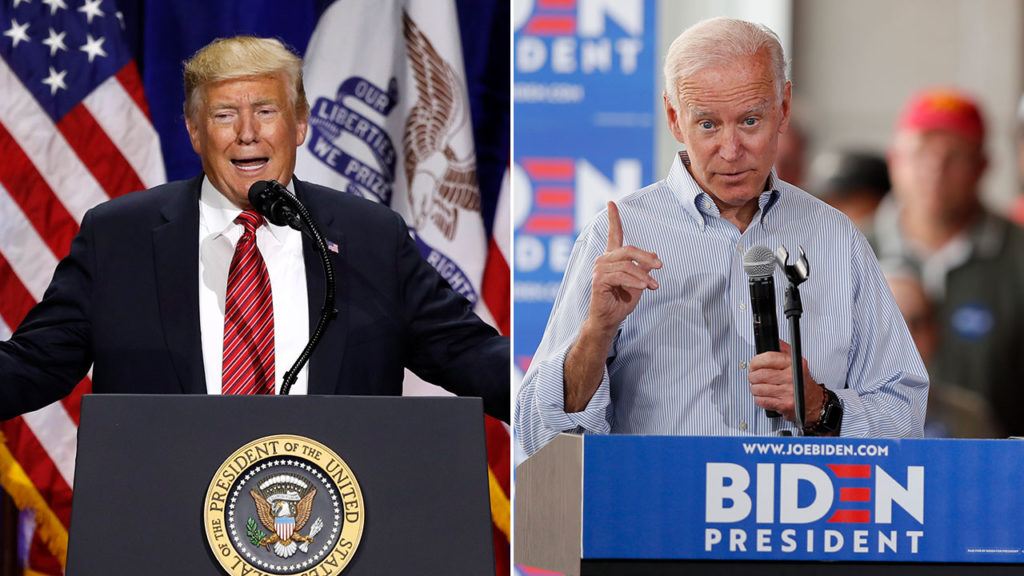President Donald Trump’s early strength in Florida on the night of the 2016 election was the first sign that he was about to score an upset victory. In an otherwise bleak 2018 for the GOP, the state was again a bright spot for Republicans who won the governor’s mansion and flipped a Senate seat.
But as another campaign heats up, Democrats aren’t ceding the Sunshine State.
Though the state has trended — by the narrowest of margins — toward Republicans in recent elections, both parties are mobilizing for a fierce and expensive battle in Florida. Democratic candidates, including early front-runner Joe Biden, have already visited the state to tap donors and connect with voters, and will descend on Miami later this month for their first round of debates. And Trump will return on Tuesday for his latest reelection announcement.
The attention is a recognition that, despite its expensive media markets and hyper-polarized politics, neither party can ignore Florida. For Trump, there are few ways for him to remain in the White House without keeping Florida’s 29 electoral votes. And for Democrats, a win here would validate the party’s emphasis on building diverse coalitions — not to mention all but obliterate Trump’s reelection prospects.
Florida Democrats say it’s wrong to interpret recent election results as the state slipping away.
“I don’t think we’re red. I don’t think we’re purple. I think we’re simply unorganized,” said former Tallahassee Mayor Andrew Gillum, the 2018 Democratic nominee for governor who lost by fewer than 33,000 votes.
Gillum’s race was one of several in recent years decided by a tiny sliver of the electorate, leaving the state a veritable graveyard of broken Democratic dreams.
Earlier this year, he launched Forward Florida, a political group meant to help Democrats retake the state in 2020, to keep Florida from being left by the wayside as Democrats try to sort out how the Trump-era political realignment has remade the presidential map.
While both parties seem convinced of the importance of the upper Midwest, fresh questions are being raised over whether the path to the White House must still run through other long-standing battlegrounds and whether others might be emerging. The Democratic super PAC Priorities USA revealed last month that its polling shows Ohio, an erstwhile swing state, now appears safer for Trump than deep-red Texas.
Still, Florida remains a key target for both parties, and Democrats have a lot of ground to make up.
Republicans have maintained an uninterrupted presence in the state since 2014, and have trained 3,000 local organizers it calls fellows, who can amplify, or in some cases replace, the voter registration and turnout work of its paid field staff.
“This is something that can’t be made up with a few checks by a failed gubernatorial candidate,” said RNC spokesman Rick Gorka.
Taking a page from the GOP’s playbook, progressive group For Our Future has been organizing in the state continuously since 2016, trying to keep Democratic voters engaged between elections. “When you lose within the margins continuously the way that we did, I think that’s an indicator that this state can still be won, but we need to do more work,” said Justin Myers, the organization’s CEO. “And that work comes from real on-the-ground organizing in the communities that matter.”
Trump has made more visits to Florida as president than to any other state, in part because he maintains a number of private golf clubs here. But advisers also said he has an affinity for the state’s avid Trump fans who have attended some of his most raucous rallies.
It’s for those reasons that in February 2017 he chose Florida to announce his bid for reelection earlier than any American leader and now 28 months later he’s returning to the state Tuesday to do it one more time.
Trump has boasted that as many as 100,000 people have tried to enter the 20,000-person Amway Center in Orlando, and the campaign has announced an outdoor “45 fest” for the overflow crowd.
The president has used the power of his office to pay special attention to Florida. During a campaign rally in Panama City Beach last month, Trump promised voters new disaster relief funding for the hurricane-hit portion of the state and additional funding for a bridge project if he was re-elected.
A string of both public and private polling has some in the president’s orbit acknowledging that carrying Florida will not be simple. Surveys by the Democratic group Priorities USA found that in Florida, like nationally, Trump gets high marks on the economy. But voters also believe the president cares more about the wealthy than about the average American.
AP Votecast’s survey of 2018 voters in the state found them roughly evenly divided on approval of Trump. And the Trump campaign’s own recent internal polls showed him trailing Democrats in early head-to-head matchups.
Most of the Democratic candidate focus on the state has been on its well-heeled donors or with an eye toward its delegate-rich primary in March, set for two weeks after Super Tuesday.
Pete Buttigieg, the mayor of South Bend, Indiana, hailed the state last month as “one of the most remarkably diverse places in the country.”
“I’m making sure that we reach out not only to the many different parts of the Latino community here, to the black community, but to people of all ages and all backgrounds,” he said.
(AP)











